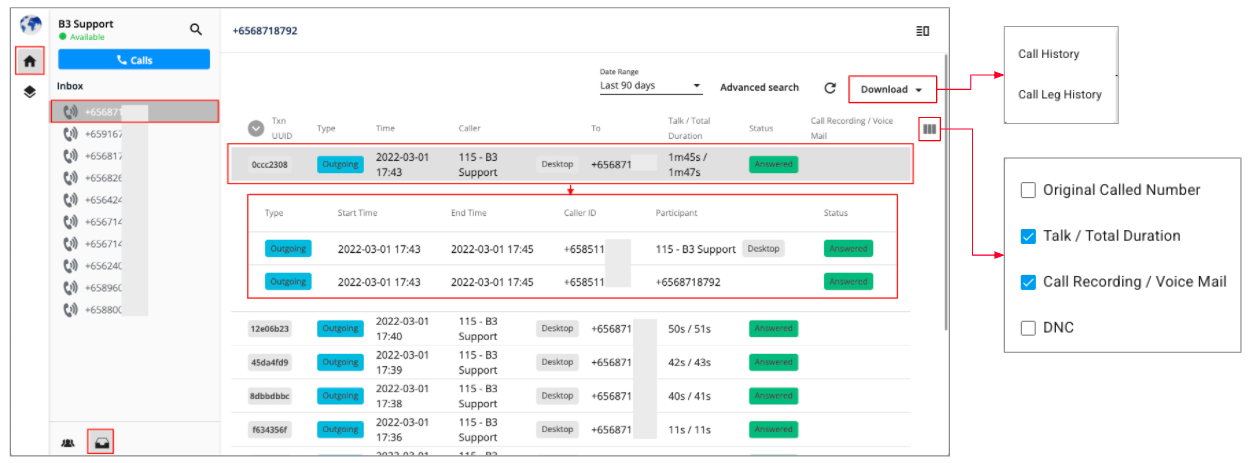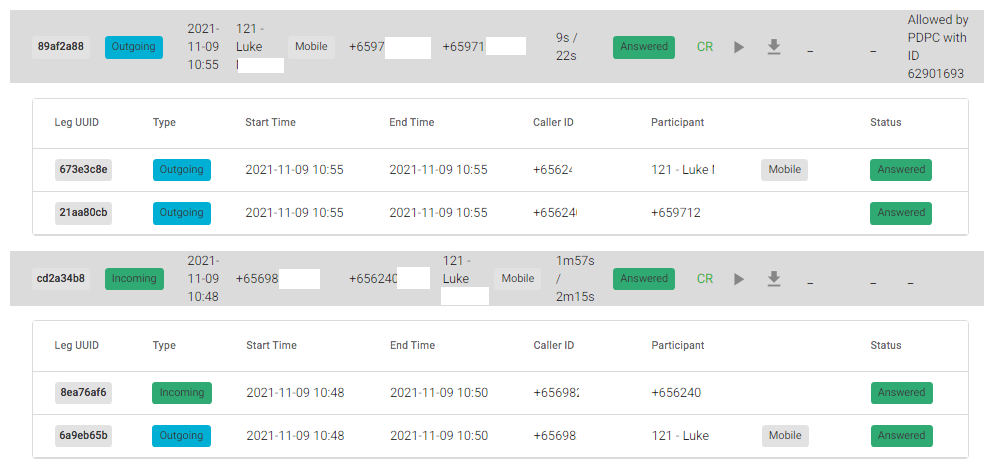Call History
- All incoming, outgoing, missed calls coming to your extension will be captured on the Homepage with complete details and can be retrieved for up to 1 year.
- This place will display all the call history based on Contact Numbers.
- Call Recording/Voicemail (if any) can be listened online and downloaded here.
Note:
Duration Limit for Voicemail is 1 minute.
To check the Call History, please follow the steps below:
- Click on the Inbox tab
- Select:
- Contact Number
- Date Range: Available within a year (started from 1/1/2021)
- Additional Columns:
- Original Called Number
- Talk/Total Duration
- Call Recording/Voice Mail
- DNC
- Advanced Search:
- Call Type:
- Incoming
- Outgoing
- Forwarding
- Call Status:
- Answered
- Unanswered
- Busy
- Cancel
- Blocked
- Failed
- Call Type:
 Call History Design
Call History Design
The call transaction is divided into 2 levels:
1. Call Transaction Level
- Main Transaction:
- Contains every basic information about a call that a user with minimum experience about call flows can still understand.
1.1 Information
| Information Name | Derivative or Sub Information | Definition & Description |
|---|---|---|
| TXN UUID | N/A | Unique transaction UUID of the call |
| Type | N/A | Type of the call, can be:* Incoming * Outgoing * Forwarding See Call Type Determination |
| Time | N/A | Begin time mark of the call |
| Caller (From) | 1. From Number (Caller ID) 2. From Extension Key 3. From Extension Label 4. From Device:* IP Phone * Mobile * Desktop * SIM | The party who initializes the call, it can be a phone number outside our system or an Extension. The Extension can be omitted but the Caller ID must be present. ****Note:In some outbound use-cases like: Call Center Auto Dialer * Callback with Ring All Devices It can have multiple outgoing legs dialed sequentially or simultaneously. Hence, the From is the outgoing leg who picked up the call first. |
| Original Called Number | N/A | The first phone number receives a call when it reaches the system. For calls blocked by DNC/Compliance, this field value is the blocked destination phone number |
| To | 1. To Number (Called Party Number) 2. To Extension Key 3. To Extension Label 4. To Device:* IP Phone * Mobile * Desktop * SIM 5. To Sip UserName | The party who FIRST answers the call. As one call can have lots of participants who join to answer the caller, the first one will always be picked as the To. Unlike Frominformation, To Number can be omitted as well as Extension/SIP endpoint, but at least one of them must be present. In Blocked calls, To will still need to be displayed properly. |
| Talk/Total Duration | * Total Duration = Call End Time - Call Start Time * Total Talk Duration: See Call Talk Time Calculation | |
| Status | Failed Reasonwill be provided for Failed/Blocked calls | Status of the call, values list:* Answered * Unanswered * Busy * Cancel * Blocked * Failed See Call Status Determination & Call Status Favored Order |
1.2 Call Type Determination Method
| Call Type | Definition | Determination Methods |
|---|---|---|
| Incoming | Calls come from outside the B3networks system. | First leg of the call has incoming type then connects to: queue, extension, SIP ring group, etc.. |
| Outgoing | Calls initialize inside the B3networks system. | First leg of the call has outgoing type |
| Forwarding | Calls come from outside the B3networks then are forwarded to outside B3networks again. | * First leg of the call has incoming type and second leg has outgoing type with endpoint is number or msisdn * First leg of the call has incoming type and second leg disposition code is REDIRECTION (indicates that destination party has configured their device to do forwarding call action) |
1.3 Call Status Determination Method
| Status\Call Type | Incoming | Outgoing | Forwarding |
|---|---|---|---|
| Answered | The incoming call (first leg) successfully connected to destination party such as:* An Auto-attendant tree * A automation bot * A SIP endpoint (IP Phone, B3works mobile, B3works desktop, etc…) and the party picked up | The caller (first leg) successfully connected to the system and the destination party (2nd~N leg) picked up the call (In callback use-case, system successfully connected to the caller and the caller picked up the call first) | The incoming call (first leg) successfully forwarded to the outside system party |
| Unanswered | The incoming call (first leg) successfully connected to the second party such as a SIP endpoint (IP Phone, B3works devices) and the party did not pick up | The caller (first leg) successfully connected to the system and the destination party did not pick up the call (In callback use-case, either the caller or the destination party did not pick up) | The caller (first leg) successfully connected to the system and the forwarded destination party did not pick up the call |
| Busy | The destination party of the incoming call was on the another call or rejected it | The destination party of the outgoing call was on the another call or rejected it (In callback use-case, either the caller or the destination party was on another call or rejected it) | The destination party of the incoming call was on the another call or rejected it |
| Cancel | The incoming call (first leg) cancelled | The caller of the outgoing call cancelled (In callback use-case, the caller first picked up then hung up the call) | The incoming call (first leg) cancelled |
| Blocked | The incoming call (first leg) was blocked to connect to the destination party by consent (DNC) or the organization’s dial plan | The outgoing call (first leg) was blocked to connect to destination party by consent (DNC) or the organization’s dial plan ****Note:*Blocked reason will be provided by DNC module | N/A |
| Failed | System failed to connect the destination party of the incoming call | System failed to connect the destination party of the outgoing call (In callback use-case, either the caller of the outgoing call or the destination party was failed to connect) *Note: There are some edge case for Outgoing call to be marked as Failed, such as:* No Outbound Rule | System failed to foward the incoming call to the destination party *Note: Failed reason will be provided by the related modules |
1.4 Call Status Favored Order
The system will base on the below priority order to determine the call status.
When to apply this:
- In the call flows where the destination has multiple active devices (Mobile, Desktop, IP Phone…).
- In the call flows where there are multiple destinations.
| Priority Order | Call Status |
|---|---|
| #1 | Answered |
| #2 | Unanswered |
| #3 | Busy |
| #4 | Cancel |
| #5 | Blocked |
| #6 | Failed |
1.5 Call Talk Time Calculation Method
| Call Type | Determination Method |
|---|---|
| Incoming | 1. Single leg call:These calls mostly are routed to Virtual Line application but not configured (or misconfigured) to connect to another endpoint.* Formula: Call End Time - Call Begin 2. Multiples legs call:* Formula: Call End Time - First Answer Time * First Answer Time: Detects by a leg (after the first leg) which first answers/connects to the call. |
| Outgoing | 1. Singel leg call:Most of these are robo calls which dial to customer number without involve an agent or connect to another endpoint:* Formula: Leg End Time - Leg Answer Time (Leg Connected Time) 2. Multiple legs call:* Formula: Call End Time - First Answer Time * First Answer Time: Detects by a leg (after the first leg) which first answers/connects to the call |
| Fowarding | Formula: 2nd Leg End Time - 2nd Answer Time (Leg Connected Time) |
2. Leg Transaction Level
- Sub Transaction:
- Contains detailed information about every participant who has ever joined a call.
2.1 Information
| Information Name | Derivative or Sub Information | Definition & Description |
|---|---|---|
| Leg UUID | N/A | Unique transaction UUID of the call leg |
| Type | N/A | Type of the leg, can be:* Incoming * Outgoing |
| Start Time | N/A | Begin time mark of the leg |
| End Time | N/A | End time mark of the leg |
| Caller ID (From) | N/A | The Caller ID which will be shown to the leg participant their device(s) |
| Participant (To) | 1. To Number 2. To Extension Key 3. To Extension Label 4. To Device:* IP Phone * Mobile * Desktop * MSISDN 5. To Sip UserName | The leg participant endpoint information |
| Status | * Answered * Unanswered * Busy * Failed * Blocked * Cancel |
2.2 Call Type Determination Method
| Call Type | Definition |
|---|---|
| Incoming(First Leg) | The incoming call connected to destination party such as:* An Auto-attendant tree * An automation bot * A SIP endpoint (IP Phone, B3works mobile, etc…) |
| Outgoing(First Leg) | The Caller connected to the system. |
| Outgoing(Second Leg) | The Caller connected to the Destination party. |
